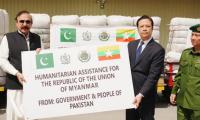After Sri Lanka’s default and the Ukraine crisis, it has become difficult to find dollars to pay for expensive oil, gas and coal.
This has made it impractical for vested interest groups to continue generating electricity through imported oil and coal in the country. Due to this, these exclusive organisations have suggested using solar power as a substitute to sell it to Wapda. These vested interest organisations have ties to the elite, and some of them identify as IPPs.
Yet the strategy is ineffective. This is how it developed. Initially, a plan was implemented to encourage the use of solar panels by reducing customs duties to zero for panels imported from Turkiye and eliminating sales tax. This initiative aimed to establish a distribution network that would allow people to purchase solar panels and be free from the burden of Wapda meters and bills. However, it has been realised that consumers will soon be liberated from Wapda if panels were installed.
Subsequently, a plan was developed for a solar plant with a capacity of 10,000 megawatts, which was then distributed across five plants with a capacity of 2,000 megawatts each. The idea was to provide solar electricity to the general public through Wapda, with bills initially being lower but gradually increasing to match the current rental power due to circular debt. However, this plan made it impossible for the average person to purchase and install solar panels.
This plan should be discouraged as it only serves private vested groups who influence public policy. Instead, these groups should sell panels directly to the people rather than generating electricity for them and selling it through Wapda.
It is worth noting that in the recent past, all ruling elites established power plants with furnace oil and sold them to the government at exorbitant rates. In some cases, power plants were run by imported coals, contributing to an increase in the import bill and the problem of circular debt.
Another issue is that agreements were made with the government based on capacity rather than usage. For example, if we need 23,000MW in the summer, companies would claim to be producing 40,000MW of power, resulting in a higher price being paid. In the winter, the same consumption would only reach 13,000, but the price would remain at 40,000MW capacity.
Rather than generating power and selling it to Wapda, these interest groups should consider setting up factories to manufacture solar panels and provide them at affordable prices to the public. This would lead to a revolution in a few years, rather than just boosting their business of power generation through solar and selling to the government. We must discourage this model and focus on developing indigenous plants for the solar system to be effective.
Pakistan has solar energy in abundance, with 360 days of general solar energy out of 365 days. The solution lies in indigenous plants selling panels and helping consumers access free electricity, rather than producing solar energy and selling it through Wapda at the state’s expense.
Recently, a private company (which provides electricity to Karachi) has launched a solar panel plant in Lasbela District of Balochistan. It will indigenously produce panels for the local market. This is the way forward to discourage the use of imports of solar panels.
If Pakistan makes the switch to renewable energy sources like solar energy, it can one day imagine being freed from the financial burden of paying $10 billion yearly for energy imports.Sweden and Greece are two examples of countries that rely heavily on renewable energy sources. Sweden generates 62.6pc of its energy from renewable sources, while Greece has achieved a remarkable 100pc renewable energy production. These countries have made significant strides in reducing their carbon footprint and promoting sustainable energy practices.
By investing in wind, solar, hydro and geothermal power, they have not only reduced their dependence on fossil fuels but also created new job opportunities and stimulated economic growth. Their success serves as a model for Pakistan to follow in the transition towards a cleaner, more sustainable future.
In summary, it is imperative that we shift our focus towards developing indigenous solar plants and providing affordable solar panels to the public. Relying on private interest groups to generate and sell solar power through Wapda is not a sustainable solution. With the advent of new technologies and alternative sources of energy like solar, it has become apparent that Wapda’s monopoly on the energy sector will come to an end anyway.
However, in the medium term, we must discourage production of electricity through furnace oil and instead prioritise the use of hydel, Thar Coal, nuclear and indigenously developed solar energy to ensure energy security for Pakistan.
To achieve this goal, we must take emergency steps to export coal from Thar and convert current foreign coal-based plants into indigenously produced coal. This will not only lead to a more sustainable and cost-effective solution for Pakistan’s energy needs but also contribute to the country’s economic growth.
Investing in renewable energy sources like solar power is not only environmentally friendly but also economically viable in the long run. By promoting the use of indigenous solar energy, we can reduce our dependence on fossil fuels and create a more sustainable future for Pakistan.
Jan Achakzai is a geopolitical analyst, a Balochistan politician and a former media and strategic communications advisor to GOB. He tweets @jan_Achakzai
Pakistan People’s Party leader Chaudhry Qamar Zaman Kaira addressing a press conference in Islamabad on January 28,...
This representational image of aerial firing. — Radio Pakistan/FileSARGODHA: The district police have urged the...
This representational image shows people offering funeral prayers. — AFP/FileMINGORA: The nine members of a family,...
Security personnel can be seen standing guard. — AFP/FilePESHAWAR: Security has been on high alert across Khyber...
Representational image shows KP police personnel standing guard on the road on August 7, 2022. — AFPMANSEHRA: A...







